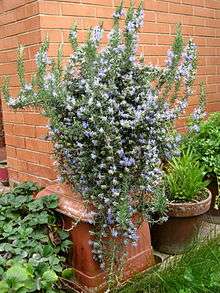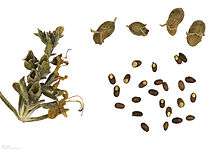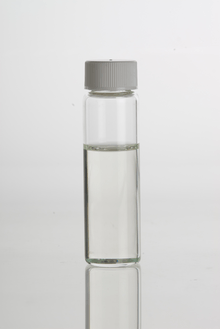Rosemary
| Rosmarinus officinalis Rosemary | |
|---|---|
| Flowering rosemary | |
| Scientific classification | |
| Kingdom: | Plantae |
| Clade: | Angiosperms |
| Clade: | Eudicots |
| Clade: | Asterids |
| Order: | Lamiales |
| Family: | Lamiaceae |
| Genus: | Rosmarinus |
| Species: | R. officinalis |
| Binomial name | |
| Rosmarinus officinalis | |
Rosmarinus officinalis, commonly known as rosemary, is a woody, perennial herb with fragrant, evergreen, needle-like leaves and white, pink, purple, or blue flowers, native to the Mediterranean region.[2]
It is a member of the mint family Lamiaceae, which includes many other herbs. The name "rosemary" derives from the Latin for "dew" (ros) and "sea" (marinus), or "dew of the sea".[3][4] The plant is also sometimes called anthos, from the ancient Greek word ἄνθος, meaning "flower".[5] Rosemary has a fibrous root system.[2]
Taxonomy
Rosmarinus officinalis is one of 2–4 species in the genus Rosmarinus.[6] The other species most often recognized is the closely related, Rosmarinus eriocalyx, of the Maghreb of Africa and Iberia. The name of ros marinus is the plant's ancient name in classical Latin. Elizabeth Kent noted in her Flora Domestica (1823), "The botanical name of this plant is compounded of two Latin words, signifying Sea-dew; and indeed Rosemary thrives best by the sea."[7] The name of the genus was applied by the 18th-century naturalist and founding taxonomist Carl Linnaeus.
Description





Rosemary is an aromatic evergreen shrub with leaves similar to hemlock needles. It is native to the Mediterranean and Asia, but is reasonably hardy in cool climates. It can withstand droughts, surviving a severe lack of water for lengthy periods.[8] Forms range from upright to trailing; the upright forms can reach 1.5 m (5 ft) tall, rarely 2 m (6 ft 7 in). The leaves are evergreen, 2–4 cm (0.8–1.6 in) long and 2–5 mm broad, green above, and white below, with dense, short, woolly hair. The plant flowers in spring and summer in temperate climates, but the plants can be in constant bloom in warm climates; flowers are white, pink, purple or deep blue.[2] Rosemary also has a tendency to flower outside its normal flowering season; it has been known to flower as late as early December, and as early as mid-February (in the northern hemisphere).[9] In some parts of the world, it is considered an invasive species.[2]
Usage
Upon cultivation, the leaves, twigs, and flowering apices are extracted for use.[10] Rosemary is used as a decorative plant in gardens where it may have pest control effects. The leaves are used to flavor various foods, such as stuffing and roast meats.
Cultivation
Since it is attractive and drought-tolerant, rosemary is used as an ornamental plant in gardens and for xeriscape landscaping, especially in regions of Mediterranean climate.[2] It is considered easy to grow and pest-resistant. Rosemary can grow quite large and retain attractiveness for many years, can be pruned into formal shapes and low hedges, and has been used for topiary. It is easily grown in pots. The groundcover cultivars spread widely, with a dense and durable texture.[2]
Rosemary grows on loam soil with good drainage in an open, sunny position. It will not withstand waterlogging and some varieties are susceptible to frost. It grows best in neutral to alkaline conditions (pH 7–7.8) with average fertility. It can be propagated from an existing plant by clipping a shoot (from a soft new growth) 10–15 cm (4–6 in) long, stripping a few leaves from the bottom, and planting it directly into soil.
Cultivars
Numerous cultivars have been selected for garden use.
- 'Albus' – white flowers
- 'Arp' – leaves light green, lemon-scented and especially cold-hardy
- 'Aureus' – leaves speckled yellow
- 'Benenden Blue' – leaves narrow, dark green
- 'Blue Boy' – dwarf, small leaves
- 'Blue Rain' – pink flowers
- 'Golden Rain' – leaves green, with yellow streaks
- 'Gold Dust' -dark green leaves, with golden streaks but stronger than 'Golden Rain'
- 'Haifa' – low and small, white flowers
- 'Irene' – low and lax, trailing, intense blue flowers
- 'Lockwood de Forest' – procumbent selection from 'Tuscan Blue'
- 'Ken Taylor' – shrubby
- 'Majorica Pink' – pink flowers
- 'Miss Jessop's Upright' – distinctive tall fastigiate form, with wider leaves.
- 'Pinkie' – pink flowers
- 'Prostratus' – lower groundcover
- 'Pyramidalis' (or 'Erectus') – fastigate form, pale blue flowers
- 'Remembrance' (or 'Gallipoli') – taken from the Gallipoli Peninsula[11]
- 'Roseus' – pink flowers
- 'Salem' – pale blue flowers, cold-hardy similar to 'Arp'
- 'Severn Sea' – spreading, low-growing, with arching branches, flowers deep violet
- 'Sudbury Blue' – blue flowers
- 'Tuscan Blue' – traditional robust upright form
- 'Wilma's Gold' – yellow leaves
The following cultivars have gained the Royal Horticultural Society's Award of Garden Merit:[12]
Culinary use
Rosemary leaves are used as a flavoring in foods,[2] such as stuffing and roast lamb, pork, chicken, and turkey. Fresh or dried leaves are used in traditional Mediterranean cuisine. They have a bitter, astringent taste and a characteristic aroma which complements many cooked foods. Herbal tea can be made from the leaves. When roasted with meats or vegetables, the leaves impart a mustard-like aroma with an additional fragrance of charred wood that goes well with barbecued foods.
In amounts typically used to flavor foods, such as one teaspoon (1 gram), rosemary provides no nutritional value.[17][18] Rosemary extract has been shown to improve the shelf life and heat stability of omega 3-rich oils which are prone to rancidity.[19]
Fragrance
Rosemary oil is used for purposes of fragrant bodily perfumes or to emit an aroma into a room. It is also burnt as incense, and used in shampoos and cleaning products.
Phytochemicals
Rosemary contains a number of phytochemicals, including rosmarinic acid, camphor, caffeic acid, ursolic acid, betulinic acid, carnosic acid, and carnosol.[20] Rosemary essential oil contains 10–20% camphor.[21]
Folklore and customs
The plant or its oil have been used in folk medicine in the belief it may have medicinal effects,[2] although there is no scientific evidence it has such properties. Rosemary was considered sacred to ancient Egyptians, Romans and Greeks.[10] Don Quixote (Part One, Chapter XVII) mixes it in his recipe of the balm, fierabras.[22]
The plant has been used as a symbol for remembrance during war commemorations and funerals in Europe and Australia.[23] Mourners would throw it into graves as a symbol of remembrance for the dead. In Shakespeare's Hamlet, Ophelia says, "There's rosemary, that's for remembrance."[24] In Australia, sprigs of rosemary are worn on ANZAC Day and sometimes Remembrance Day to signify remembrance; the herb grows wild on the Gallipoli Peninsula.[23]
See also
References
- ↑ "Rosmarinus officinalis". Germplasm Resources Information Network (GRIN). Agricultural Research Service (ARS), United States Department of Agriculture (USDA). Retrieved 2008-03-03.
- 1 2 3 4 5 6 7 8 "Rosmarinus officinalis (rosemary)". Centre for Agriculture and Bioscience International. 3 January 2018. Retrieved 13 July 2018.
- ↑ Room, Adrian (1988). A Dictionary of True Etymologies. Taylor & Francis. p. 150. ISBN 978-0-415-03060-1.
- ↑ Wedgwood, Hensleigh (1855). "On False Etymologies". Transactions of the Philological Society (6): 66.
- ↑ "The month." The Pharmaceutical Journal and Transactions: A Weekly Record of Pharmacy and Allied Sciences. Published by the Pharmaceutical Society of Great Britain. April 1887. 804–804
- ↑ Rosselló, J. A.; Cosín, R.; Boscaiu, M.; Vicente, O.; Martínez, I.; Soriano, P. (2006). "Intragenomic diversity and phylogenetic systematics of wild rosemaries (Rosmarinus officinalis L. s.l., Lamiaceae) assessed by nuclear ribosomal DNA sequences (ITS)". Plant Systematics and Evolution. 262 (1–2): 1–12. doi:10.1007/s00606-006-0454-5. JSTOR i23655428.
- ↑ Kent, Elizabeth (1823). Flora Domestica, or the Portable Flower-Garden. Taylor and Hessey. p. 330.
- ↑ "How to Grow Rosemary". Garden Action. Retrieved 10 November 2011.
- ↑ McCoy, Michael (27 June 2012). "The good graces of rosemary". The Gardenist. Retrieved 10 April 2015.
- 1 2 Burlando, Bruno; Verotta, Luisella; Cornara, Laura; Bottini-Massa, Elisa (2010). Herbal Principles in Cosmetics Properties and Mechanisms of Action. Boca Raton, Florida: CRC Press. p. 303. ISBN 978-1-4398-1214-3.
- ↑ Rosemary. Gardenclinic.com.au. Retrieved on 2014-06-03.
- ↑ "AGM Plants - Ornamental" (PDF). Royal Horticultural Society. July 2017. p. 93. Retrieved 10 October 2018.
- ↑ "Rosmarinus officinalis 'Miss Jessopp's Upright'". Royal Horticultural Society. Retrieved 3 June 2014.
- ↑ "Rosmarinus officinalis 'Severn Sea'". Royal Horticultural Society. Retrieved 3 June 2014.
- ↑ "Rosmarinus officinalis 'Sissinghurst Blue'". Royal Horticultural Society. Retrieved 3 June 2014.
- ↑ "Rosmarinus officinalis var. angustissimus 'Benenden Blue'". Royal Horticultural Society. Retrieved 3 June 2014.
- ↑ "Nutrition Facts – Dried rosemary, one teaspoon (1 g)". nutritiondata.com. Conde Nast, USDA Nutrient Database, version SR-21. 2014.
- ↑ "USDA National Nutrient Database for Standard Reference". NAL.usda.gov. US Department of Agriculture. 2014. Retrieved 3 June 2014.
- ↑ Daniells, Stephen (20 November 2017). "Oregano, rosemary extracts promise omega-3 preservation". Food Navigator.
- ↑ Vallverdú-Queralt, Anna; Regueiro, Jorge; Martínez-Huélamo, Miriam; Rinaldi Alvarenga, José Fernando; Leal, Leonel Neto; Lamuela-Raventos, Rosa M. (2014). "A comprehensive study on the phenolic profile of widely used culinary herbs and spices: Rosemary, thyme, oregano, cinnamon, cumin and bay". Food Chemistry. 154: 299–307. doi:10.1016/j.foodchem.2013.12.106. PMID 24518346.
- ↑ "Rosemary | Professional". Drugs.com. Retrieved 23 July 2016.
- ↑ Capuano, Rhomas M. (2005). "Las huellas de otro texto médico en Don Quijote: Las virtudes del romero". Romance Notes (in Spanish). 45 (3): 303–310.
- 1 2 "Rosemary". Australian War Memorial. Archived from the original on 19 December 2013. Retrieved 10 November 2011.
- ↑ Shakespeare, William. Scene 13. Hamlet.
External links
| Wikispecies has information related to Rosmarinus officinalis |
| Wikibooks Cookbook has a recipe/module on |
| Wikimedia Commons has media related to Rosmarinus officinalis. |

- Rosemary List of Chemicals (Dr. Duke's)